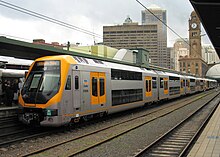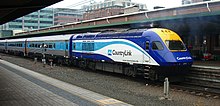Railway in New South Wales
The New South Wales railroad comprises the largest rail network in Australia . She played a major role in the development of the state. Most of the lines were built in standard gauge and by the state.
Beginnings

Gauge
Since the colonies were legally independent from each other before the amalgamation of the Australian federal state in 1901, the decision on the gauge in which the respective railroad was to be built was a matter for the individual colony. Originally, the law of July 27, 1852 provided for the New South Wales railway network to be built in a broad gauge of 1,600 mm (5 feet 3 inches). This was given up shortly afterwards in favor of the standard gauge , as the mother country, Great Britain , had spoken out in favor of its own network. That was taken over.
Redfern-Paramatta
The construction of the first line from Redfern ( Sydney ) to Paramatta from 1850, for which the Sydney Railway Company was founded on October 10, 1849 , turned out to be difficult: labor in the colony was difficult to find and therefore expensive, as originally estimated Costs were far exceeded and the project manager resigned. The originally planned wooden bridges and wooden rails (!) Have now been abandoned and from 1854 a connection to Darling Harbor has been built. The resulting financial chaos was absorbed by the fact that the colony took over the project under state sponsorship. The first locomotives were supplied by Robert Stephenson & Co. from England . From September 26, 1855, the operation of this 22 km long railway line began.
Newcastle
From 1853 onwards , regardless of the beginnings in Sydney and the surrounding area, a number of both state and private railway lines were built in the Newcastle area, which were used to transport coal mined there. This means that the fuel for the locomotives was already available on site, which promoted the development of the railway network. The networks of Sydney and Newcastle had to wait until 1889 for a rail connection, as the crossing of the wide Hawkesbury River was very complex.
Network development

Network development in NSW
With the chief engineer John Whitton then from 1857 the construction of a railway network for the colony was pursued. Goulburn in the southwest of Sydney, Murrurundi in the north and Bathurst in the west were reached. For the latter, the Blue Mountains had to be crossed, which required extremely complex engineering structures on both sides of the mountain, each with a series of switchbacks . They were built in 1867 and 1869 and replaced by deeper tunnels in 1910. The western hairpin is preserved as a museum as the Zig Zag Railway . In a report prepared for UNESCO , consideration was given to adding this technical cultural monument to the list of World Heritage of Humanity. In 1883 the border and connection to the Victoria Colony network was reached in Albury . However, due to the different track widths, it was initially not possible for the trains to pass through. Passengers had to change trains, goods had to be reloaded. In 1886 Bourke was reached. The line leading to the village was at that time the longest straight stretch of railway in the world, only replaced in this record by the 478 km long straight line of the Transaustralian Railway , which went into operation in 1917. In 1906, Sydney Central Railway Station went into operation. The station is equipped with 27 platform tracks (25 of which are operated) still the largest in Australia. In 1927 Broken Hill, the far west of the state, was reached via a 30 km long, narrow-gauge, private railway, the Silverton Tramway , which connects to the railway from South Australia . However, this was built in narrow gauge here , so that travelers had to change trains here and goods had to be reloaded. At the same time, however, this was also an important future segment of today's Trans-Australian Railway . The 8 km short Australian Capital Territory Railway to Canberra , whose infrastructure is owned by the Australian Confederation , has been operated by the New South Wales Railway since it opened in 1914 .
The standard gauge network of New South Wales in the north reached the border with Queensland in 1888 , where a change had to be made because the railway there had been built in Cape Gauge . The used today, shorter standard gauge track has been around since 1932. Since 1962 it is possible, using an in Victoria underlying three-rail track continuously to standard gauge and from the network of New South Wales until after Melbourne drive through. Almost 50 years later, the line was completely rebuilt to standard gauge. Since 1970 it has been possible to use standard gauge from the network in New South Wales to Perth in Western Australia .
Local transport in the greater Sydney area
From 1926, Sydney received an electrified S-Bahn network that also functions as a subway in the city center . Today it is used by the railway company CityRail operates. In the last few years, increasing importance has been attached to expanding this network in the constantly growing metropolitan region . The last new builds were the Airport and East Hills railway line (opened in 2000) and the Epping and Chatswood Rail Link in 2009.
Modern
After the Second World War , the steam locomotives were increasingly replaced by diesel locomotives and diesel multiple units and air-conditioned trains were used in passenger transport. From the 1960s, the importance of the railroad as a means of transport also declined in New South Wales. This led to numerous branch lines being abandoned. However, the railway has a strong position in transcontinental freight traffic, especially in container trains and in local traffic in the Sydney metropolitan area. Long-distance passenger transport only plays a subordinate role.
In the first hundred years, the network of the state railway grew from 22 km to 9387 km. It has decreased a bit since then. The name of the state railway company is currently: Rail Corporation New South Wales , after the name has been changed over and over again in the course of history ( New South Wales Railways , New South Wales Government Railways ). The freight traffic is however outsourced and is operated by Pacific National .
Web links
- www.nswrail.net Opening and closing dates of railway lines in NSW (English)
literature
- Jim Powe: Trains and Railways of Australia . 2nd ed. Sydney 2009. ISBN 9781741109023
Movie
- Beyer-Garratt Locomotives Round the World: New South Wales . Great Britain 1951–1953. 16 mm color film, silent film , 28 minutes.
Individual evidence
- ^ Anthony Coulls, Railways as World Heritage Sites = Occasional Papers for the World Heritage Convention, ed .: International Council on Monuments and Sites (ICOMOS), Paris 1999, p. 15
- ^ After John Huntley: Railways in the Cinema . London 1969, p. 115, available from the British Film Institute .






